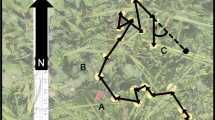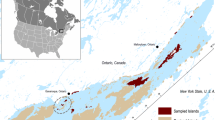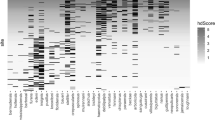Abstract
Context
Landscape changes can be an important modifier of disease. Habitat fragmentation commonly results in reduced connectivity in host populations and increased use of the remaining habitat. For environmentally transmitted parasites, this presents a possible trade-off between transmission potential at the local and global level.
Objectives
We quantify the effects of fragmentation on the transmission of an environmentally transmitted parasite, teasing apart the relative effects of habitat composition and configuration on both host movement behaviour and subsequent infection patterns.
Methods
We use a spatially-explicit epidemiological model to simulate the effects of habitat fragmentation, using, as an example, whipworm (Trichuris sp.) within a red colobus monkey population (Procolobus rufomitratus).
Results
We found that habitat fragmentation did not always lead to a trade-off between population connectivity and concentration of habitat use in host movement behaviour or in final population infection patterns. However, our simulation results suggest the spatial configuration of the remaining habitat became increasingly influential on behavioural and infection outcomes as habitat was removed. Additionally, we found common fragmentation metrics provided little ability to explain variation in propagation of infections.
Conclusions
Our results suggest an interaction between habitat configuration and composition should be considered when assessing disease related impacts of habitat fragmentation on environmentally transmitted parasites, especially in cases where habitat loss is high (≥ 30%). We also propose that spatially-explicit simulations that capture a host’s response to fragmentation could aid in the development of novel landscape metrics targeted towards specific host-parasite-landscape systems.





Similar content being viewed by others
References
Allan BF, Keesing F, Ostfeld RS (2003) Effect of forest fragmentation on Lyme disease risk. Conserv Biol 17:267–272
Bélisle M (2005) Measuring landscape connectivity: the challenge of behavioral landscape ecology. Ecology 86:1988–1995
Bonnell TR, Campennì M, Chapman CA, Gogarten JF, Reyna-Hurtado RA, Teichroeb JA, Wasserman MD, Sengupta R (2013a) Emergent group level navigation: an agent-based evaluation of movement patterns in a folivorous primate. PLoS ONE 8:e78264
Bonnell TR, Dutilleul P, Chapman CA, Reyna-Hurtado R, Uriel Hernandez-Sarabia R, Sengupta R (2013b) Analysing small-scale aggregation in animal visits in space and time: the ST-BBD method. Anim Behav 85:483–492
Bonnell TR, Ghai RR, Goldberg TL, Sengupta R, Chapman CA (2016a) Spatial patterns of persistence for environmentally transmitted parasites: effects of regional climate and local landscape. Ecol Model 338:78–89
Bonnell TR, Henzi SP, Barrett L (2016b) Direction matching for sparse movement data sets: determining interaction rules in social groups. Behav Ecol. 28: 193–203.https://doi.org/10.1093/beheco/arw145
Brearley G, Rhodes J, Bradley A, Baxter G, Seabrook L, Lunney D, Liu Y, McAlpine C (2013) Wildlife disease prevalence in human-modified landscapes. Biol Rev 88:427–442
Brownstein JS, Skelly DK, Holford TR, Fish D (2005) Forest fragmentation predicts local scale heterogeneity of Lyme disease risk. Oecologia 146:469–475
Chapman CA, Gillespie TR, Speirs ML (2005) Parasite prevalence and richness in sympatric colobines: effects of host density. Am J Primatol 67:259–266
Chapman CA, Wasserman MD, Gillespie TR, Speirs ML, Lawes MJ, Saj TL, Ziegler TE (2006) Do food availability, parasitism, and stress have synergistic effects on red colobus populations living in forest fragments? Am J Phys Anthropol 131:525–534
Chapman CA, Saj TL, Snaith TV (2007) Temporal dynamics of nutrition, parasitism, and stress in colobus monkeys: implications for population regulation and conservation. Am J Phys Anthropol 134:240–250
Chapman CA, Ghai RR, Reyna-Hurtado R, Jacob AL, Koojo SM, Rothman JM, Twinomugisha D, Wasserman MD, Goldberg TL (2013) Going, going, gone: a 15-year history of the decline in abundance of primates in forest fragments. In: Marsh LK, Chapman CA (eds) Primates in fragments: complexity and resilience. Springer, New York
Chapman CA, Schoof VA, Bonnell TR, Gogarten JF, Calmé S (2015) Competing pressures on populations: long-term dynamics of food availability, food quality, disease, stress and animal abundance. Philos Trans R Soc Lond 370:20140112
Coulon A, Cosson J, Angibault J, Cargnelutti B, Galan M, Morellet N, Petit E, Aulagnier S, Hewison A (2004) Landscape connectivity influences gene flow in a roe deer population inhabiting a fragmented landscape: an individual–based approach. Mol Ecol 13:2841–2850
Debinski DM, Holt RD (2000) A survey and overview of habitat fragmentation experiments. Conserv Biol 14:342–355
Dion E, VanSchalkwyk L, Lambin EF (2011) The landscape epidemiology of foot-and-mouth disease in South Africa: a spatially explicit multi-agent simulation. Ecol Model 222:2059–2072
Estrada E, Bodin Ö (2008) Using network centrality measures to manage landscape connectivity. Ecol Appl 18:1810–1825
Evans MR, Grimm V, Johst K, Knuuttila T, De Langhe R, Lessells CM, Merz M, O’Malley MA, Orzack SH, Weisberg M (2013) Do simple models lead to generality in ecology? Trends Ecol Evol 28:578–583
Ewers RM, Didham RK (2006) Confounding factors in the detection of species responses to habitat fragmentation. Biol Rev Camb Philos Soc 81:117–142
Fahrig L (1998) When does fragmentation of breeding habitat affect population survival? Ecol Model 105:273–292
Farnsworth ML, Wolfe LL, Hobbs NT, Burnham KP, Williams ES, Theobald DM, Conner MM, Miller MW (2005) Human land use influences chronic wasting disease prevalence in mule deer. Ecol Appl 15:119–126
Flather CH, Bevers M (2002) Patchy reaction-diffusion and population abundance: the relative importance of habitat amount and arrangement. Am Nat 159:40–56
Ghai RR, Fugère V, Chapman CA, Goldberg TL, Davies TJ (2015) Sickness behaviour associated with non-lethal infections in wild primates. Proc R Soc London B 282:20151436
Gillespie TR, Chapman CA (2006) Prediction of parasite infection dynamics in primate metapopulations based on attributes of forest fragmentation. Conserv Biol 20:441–448
Gillespie TR, Chapman CA (2008) Forest fragmentation, the decline of an endangered primate, and changes in host–parasite interactions relative to an unfragmented forest. Am J Primatol 70:222–230
Gogarten JF, Jacob AL, Ghai RR, Rothman JM, Twinomugisha D, Wasserman MD, Chapman CA (2014) Group size dynamics over 15 + years in an African forest primate community. Biotropica 47:101–112
Goldberg TL, Paige SB, Chapman CA (2012) The Kibale eco health project. In: Aguirre AA, Ostfeld RS, Daszak P (eds) New direcitons in conservation medicine. Oxford University Press, New York
Gulland F (1992) The role of nematode parasites in Soay sheep (Ovis aries L.) mortality during a population crash. Parasitology-Cambridge 105:493
Hothorn T, Bretz F, Westfall P (2008) Simultaneous inference in general parametric models. Biom J 50:346–363
Kays R, Crofoot MC, Jetz W, Wikelski M (2015) Terrestrial animal tracking as an eye on life and planet. Science 348:2478
Keeling MJ, Rohani P (2008) Modeling infectious diseases in humans and animals. Princeton University Press, Princeton
Keeling MJ, Woolhouse MEJ, May RM, Davies G, Grenfell BT (2003) Modelling vaccination strategies against foot-and-mouth disease. Nature 421:136–142
Kupfer JA (2012) Landscape ecology and biogeography: rethinking landscape metrics in a post-FRAGSTATS landscape. Prog Phys Geogr 36:400–420
Lane-deGraaf KE, Kennedy RC, Arifin SMN, Madey GR, Fuentes A, Hollocher H (2013) A test of agent-based models as a tool for predicting patterns of pathogen transmission in complex landscapes. BMC Ecol 13:35
Langlois JP, Fahrig L, Merriam G, Artsob H (2001) Landscape structure influences continental distribution of hantavirus in deer mice. Landscape Ecol 16:255–266
Linard C, Poncon N, Fontenille D, Lambin EF (2009) A multi-agent simulation to assess the risk of malaria re-emergence in southern France. Ecol Model 220:160–174
McCallum H, Dobson A (2002) Disease, habitat fragmentation and conservation. Proc Natl Acad Sci USA 269:2041–2049
McGarigal K, Cushman SA, Neel MC, Ene E (2002) FRAGSTATS: spatial pattern analysis program for categorical maps. University of Massachusetts, Boston
Morgan ER, Milner-Gulland EJ, Torgerson PR, Medley GF (2004) Ruminating on complexity: macroparasites of wildlife and livestock. Trends Ecol Evol 19:181–188
Nathan R, Getz WM, Revilla E, Holyoak M, Kadmon R, Saltz D, Smouse PE (2008) A movement ecology paradigm for unifying organismal movement research. Proc Natl Acad Sci USA 105:19052–19059
Nunn CL, Thrall PH, Leendertz FH, Boesch C (2011) The spread of fecally transmitted parasites in socially-structured populations. PLoS ONE 6:e21677
Nunn CL, Thrall PH, Kappeler PM (2014) Shared resources and disease dynamics in spatially structured populations. Ecol Model 272:198–207
R Core Team (2016) R: a language and environment for statistical computing. R Foundation for Statistical Computing, Vienna
Rivest L-P, Duchesne T, Nicosia A, Fortin D (2016) A general angular regression model for the analysis of data on animal movement in ecology. J R Stat Soc 65:445–463
Rulli MC, Santini M, Hayman DTS, D’Odorico P (2017) The nexus between forest fragmentation in Africa and Ebola virus disease outbreaks. Sci Rep 7:41613
Sarkar D, Chapman CA, Griffin L, Sengupta R (2014) Analyzing animal movement characteristics from location data. Trans GIS 19(4):516–534
Smith AC, Koper N, Francis CM, Fahrig L (2009) Confronting collinearity: comparing methods for disentangling the effects of habitat loss and fragmentation. Landscape Ecol 24:1271
Stoner KE (1996) Prevalence and intensity of intestinal parasites in mantled howling monkeys (Alouatta palliata) in northeastern Costa Rica: implications for conservation biology. Conserv Biol 10:539–546
Strandburg-Peshkin A, Farine DR, Couzin ID, Crofoot MC (2015) Shared decision-making drives collective movement in wild baboons. Science 348:1358–1361
Struhsaker TT (2010) The Red Colobus Monkeys: variation in demography, behavior, and ecology of endangered species. Oxford University Press, Oxford
Telfer S, Lambin X, Birtles R, Beldomenico P, Burthe S, Paterson S, Begon M (2010) Species interactions in a parasite community drive infection risk in a wildlife population. Science 330:243–246
White LA, Forester JD, Craft ME (2017) Dynamic, spatial models of parasite transmission in wildlife: their structure, applications and remaining challenges. J Anim Ecol. 87:559–580. https://doi.org/10.1111/1365-2656.12761
Wiegand T, Revilla E, Moloney KA (2005) Effects of habitat loss and fragmentation on population dynamics. Conserv Biol 19:108–121
Wiens JA (1995) Habitat fragmentation: island v landscape perspectives on bird conservation. Ibis 137:S97–S104
Wilson MC, Chen X-Y, Corlett RT, Didham RK, Ding P, Holt RD, Holyoak M, Hu G, Hughes AC, Jiang L, Laurance WF, Liu J, Pimm SL, Robinson SK, Russo SE, Si X, Wilcove DS, Wu J, Yu M (2016) Habitat fragmentation and biodiversity conservation: key findings and future challenges. Landscape Ecol 31:219–227
Acknowledgements
We gratefully acknowledge the Uganda National Council for Science and Technology and the Uganda Wildlife Authority for permission to conduct this research, as well as two anonymous reviewers who gave helpful comments on this manuscript. Funding for the research was provided by the Canada Research Chairs Program, Natural Science and Engineering Research Council of Canada, Kyoto University, Fonds Québécois de la Recherche sur la Nature et les Technologies, National Geographic and by NIH grant TW009237 as part of the joint NIH-NSF Ecology of Infectious Disease program and the UK Economic and Social Research Council. TRB was supported by an FQRNT Fellowship.
Author information
Authors and Affiliations
Corresponding author
Electronic supplementary material
Below is the link to the electronic supplementary material.
Rights and permissions
About this article
Cite this article
Bonnell, T.R., Ghai, R.R., Goldberg, T.L. et al. Spatial configuration becomes more important with increasing habitat loss: a simulation study of environmentally-transmitted parasites. Landscape Ecol 33, 1259–1272 (2018). https://doi.org/10.1007/s10980-018-0666-4
Received:
Accepted:
Published:
Issue Date:
DOI: https://doi.org/10.1007/s10980-018-0666-4




